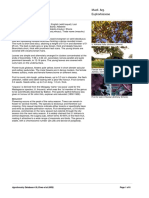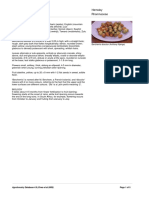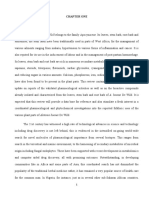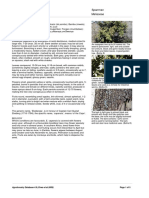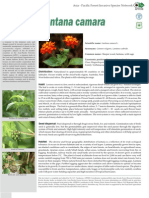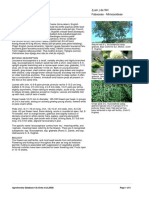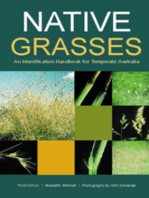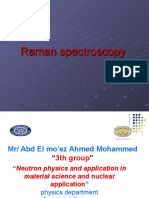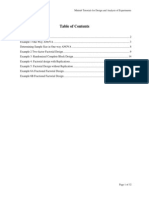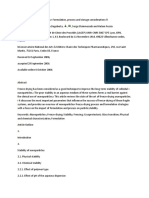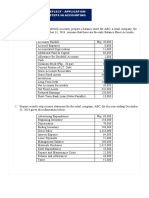Professional Documents
Culture Documents
Vangueria infausta fruit and uses
Uploaded by
NanoManOriginal Description:
Original Title
Copyright
Available Formats
Share this document
Did you find this document useful?
Is this content inappropriate?
Report this DocumentCopyright:
Available Formats
Vangueria infausta fruit and uses
Uploaded by
NanoManCopyright:
Available Formats
Vangueria infausta
Burchell Rubiaceae
LOCAL NAMES Afrikaans (wildemispel,grootmispel); English (wild medlar); Swahili (viru,mviru,muiru,mtiegu); Zulu (umViyo) BOTANIC DESCRIPTION Vangueria infausta is a deciduous tree 3-8 m in height with a short trunk and hanging branchlets. Bark pale grey-brown, peeling in untidy flakes; branches usually opposite with reddish tomentose young branchlets. Leaves dull green, opposite, rusty tomentose, medium to large, 5-24 x 3.815 cm, shape varying from ovate or obovate to lanceolate or rounded; netveining, conspicuous below. Leaf apices either obtuse or sub-acuminate; base tapering; margin entire; petiole 3-10 mm long. Leaf stalks short, 5-10 mm long; stipules long, between young leaves. Flowers about 4 mm long and 6 mm in diameter, hairy, profusely borne on opposite and axillary cymes; petals yellow-green, the corolla falling early to leave 5 triangular sepals less than 2 mm long on the young green fruit; buds pointed. Fruit subglobose, glossy, 3-6.5 x 3.5-6 cm, greenish when unripe, turning brownish after ripening and with a soft fleshy pulp. The fruit bears a characteristic star-shaped scar from the remains of the calyx. It contains 35 hard-coated seeds, 2-3 cm long, 1-5 cm wide. The generic name Vangueria is derived from a Malagasy word, and infausta means unlucky; making fire with the wood is taboo. BIOLOGY In southern Africa, the tree flowers from September to November and fruits from November to April.
The bark is grey and smooth, becoming roughish and longitudinally grooved with age. (Botha AD) The fruit is crowned with a circular scar left by the calyx. (Botha AD) Flowers (Botha AD)
Agroforestry Database 4.0 (Orwa et al.2009)
Page 1 of 5
Vangueria infausta
Burchell Rubiaceae
ECOLOGY V. infausta is found in all types of woodland, especially on rocky ridges and hillsides or in wooded grassland; also near the sea on sand dunes. It can withstand long periods of drought and frost. Widely distributed in savannah-like communities derived from forest (including forest remnants), and often in rocky or sandy places. BIOPHYSICAL LIMITS Altitude: 350-1 250 m, Mean annual temperature: 17-28 deg.C, Mean annual rainfall: 1 000- 1 500 mm Soil type: Prefers red or yellow-red, gritty sandy clay loams (latosolic soils) and brown clay loams. Also found on red to dark red friable clays with laterite horizon and on coral-rag soils derived from granites and granodiorite rocks.
DOCUMENTED SPECIES DISTRIBUTION
Native: Exotic: Botswana, Kenya, Madagascar, Malawi, Mozambique, Namibia, South Africa, Tanzania, Uganda, Zimbabwe
Native range
Exotic range
The map above shows countries where the species has been planted. It does neither suggest that the species can be planted in every ecological zone within that country, nor that the species can not be planted in other countries than those depicted. Since some tree species are invasive, you need to follow biosafety procedures that apply to your planting site.
Agroforestry Database 4.0 (Orwa et al.2009)
Page 2 of 5
Vangueria
The map above shows countries where the species has been planted. It does neither suggest that the species can be planted in every ecological zone within that country, nor that the species can not be planted in other countries than those depicted. Since Burchell infausta species are invasive, you need to follow biosafety procedures that apply to some tree your planting site. Rubiaceae
PRODUCTS Food: The fruits are eaten raw and the pulp sometimes soaked in water and then dried to use later. The pulp, when mixed with a little sugar and water, makes a good substitute for applesauce; it has a sweet and slightly sour taste. Each 100 g fresh fruit contain 3.7 g vitamin C, 1.4 g protein, 28 g carbohydrate, 28 mg sodium, 0.61 mg nicotinic acid and high levels of calcium and magnesium. Seeds can be eaten roasted. Fodder: The leaves of V. infausta are seldom browsed by cattle, but very much so by goats, and the leaves and young branches are eaten by elephant, giraffe, kudu and nyala. Red-footed squirrels, bushbabies, vervet monkeys and baboons eat the fruit on the tree, and bushpig eat it on the ground. Fuel: V. infausta is a good source of firewood. Timber: Poles for houses, agricultural implements and handles are some of the ways in which the wood is utilized. Alcohol: In South Africa, farmers distil mampoer from the ripe fruit. Medicine: Traditional healers use the roots for a variety of illnesses such as malaria and pneumonia. An infusion made from the roots is used to treat coughs and other chest troubles. A decoction from the root is used as a purgative and an anthelmintic (especially for Ascaris), and is also a popular snakebite remedy. The pounded leaves are applied to tickbite sores on livestock and dogs to speed up healing. A poultice made of the leaves is used to treat swellings on the legs and inflammation of the navel in children. An infusion of the leaves is used in treating abdominal pain and for the relief of dental pain. In southern Africa, a decoction is used as a remedy for menstrual troubles.
Agroforestry Database 4.0 (Orwa et al.2009)
Page 3 of 5
Vangueria infausta
Burchell Rubiaceae
TREE MANAGEMENT Young plants transplant well but must receive regular watering for the 1st 5 weeks after transplanting. They are light demanding, and the growth rate is usually slow; 40-50 cm/year. Groups of V. infausta can be planted scattered in fields, near water points and along homestead fences. The flowers attract insects, which in turn attract insect-eating birds. GERMPLASM MANAGEMENT Seed storage behaviour is orthodox; seed can retain viability for up to 1 year in storage if dried properly. There are about 500 seeds/kg. PESTS AND DISEASES Fruit-eating birds feast on the abundant ripe fruit, sometimes leaving only the skin for the hungry traveller. Small galllike growths that may appear on the leaf surfaces are caused by a species of fungus.
Agroforestry Database 4.0 (Orwa et al.2009)
Page 4 of 5
Vangueria infausta
Burchell Rubiaceae
FURTHER READNG
Beentje HJ. 1994. Kenya trees, shrubs and lianas. National Museums of Kenya. Coates-Palgrave K. 1988. Trees of southern Africa. C.S. Struik Publishers Cape Town. FAO. 1983. Food and fruit bearing forest species. 1: Examples from Eastern Africa. FAO Forestry Paper. 44/1. Rome. Hines DA, Eckman K. 1993. Indigenous multipurpose trees for Tanzania: uses and economic benefits to the people. Cultural survival Canada and Development Services Foundation of Tanzania. Hong TD, Linington S, Ellis RH. 1996. Seed storage behaviour: a compendium. Handbooks for Genebanks: No. 4. IPGRI. Kokwaro JO. 1976. Medicinal plants of East Africa. East African Literature Bureau. Mbuya LP et al. 1994. Useful trees and shrubs for Tanzania: Identification, Propagation and Management for Agricultural and Pastoral Communities. Regional Soil Conservation Unit (RSCU), Swedish International Development Authority (SIDA). Tietema T, Merkesdal E and Schroten J. 1992. Seed germination of indigenous trees in Botswana. Acts Press. Venter F, Venter J-A. 1996. Making the most of Indigenous trees. Briza Publications. Watt JM, Breyer-Brandwijk. 1962. Medicinal and poisonous plants of southern and eastern Africa. E & S Livingstone Ltd.
SUGGESTED CITATION
Orwa C, Mutua A , Kindt R , Jamnadass R, Simons A. 2009. Agroforestree Database:a tree reference and selection guide version 4.0 (http://www.worldagroforestry.org/af/treedb/)
Agroforestry Database 4.0 (Orwa et al.2009)
Page 5 of 5
You might also like
- Uapaca Kirkiana: Euphorbiaceae Muell. ArgDocument6 pagesUapaca Kirkiana: Euphorbiaceae Muell. ArgvitazzoNo ratings yet
- Schinus MolleDocument5 pagesSchinus MolleFlower Rouss AQNo ratings yet
- Berchemia DiscolorDocument5 pagesBerchemia DiscolorvitazzoNo ratings yet
- Spondias Mombin: Anacardiaceae LDocument5 pagesSpondias Mombin: Anacardiaceae LMaria José PradoNo ratings yet
- Flacourtia IndicaDocument5 pagesFlacourtia IndicaGiffaria HafizhaNo ratings yet
- Maesopsis EminiiDocument5 pagesMaesopsis EminiiRizki Ersa HeryanaNo ratings yet
- Genipa americana: The marmalade box treeDocument5 pagesGenipa americana: The marmalade box treevitazzoNo ratings yet
- Juniperus Procera: Cupressaceae Hochst. Ex EndlDocument5 pagesJuniperus Procera: Cupressaceae Hochst. Ex EndlgravitzNo ratings yet
- Vernonia Factsheet PDFDocument2 pagesVernonia Factsheet PDFSo NicNo ratings yet
- Annona SquamosaDocument5 pagesAnnona SquamosaPhan Thanh TrangNo ratings yet
- Erythrina - Poeppigiana ICRAFDocument5 pagesErythrina - Poeppigiana ICRAFAndres TelloNo ratings yet
- Erythrina poeppigiana: A Shade Tree for CacaoDocument5 pagesErythrina poeppigiana: A Shade Tree for CacaomichaelNo ratings yet
- Ficus Religiosa: Moraceae LDocument5 pagesFicus Religiosa: Moraceae LSimon SpillerNo ratings yet
- Prosopis Juliflora: Fabaceae - Mimosoideae (SW.) DCDocument5 pagesProsopis Juliflora: Fabaceae - Mimosoideae (SW.) DCMara LiceoNo ratings yet
- Mwangomo-Assigniment 01Document86 pagesMwangomo-Assigniment 01Denis MwangomoNo ratings yet
- Invasive Flora of the West Coast: British Columbia and the Pacific NorthwestFrom EverandInvasive Flora of the West Coast: British Columbia and the Pacific NorthwestNo ratings yet
- Fraxinus excelsior: The Common European AshDocument5 pagesFraxinus excelsior: The Common European AshKarelNo ratings yet
- 29 Edible Plants in The PhilippinesDocument0 pages29 Edible Plants in The PhilippinesChristine Carreon100% (3)
- Morinda Species ProfileDocument13 pagesMorinda Species ProfilebahbaguruNo ratings yet
- Morinda NoniDocument19 pagesMorinda NoniSofian SahoriNo ratings yet
- Trees Inside Benguet State University PDFDocument39 pagesTrees Inside Benguet State University PDFDerrick Yson (Mangga Han)No ratings yet
- Ecology Project Group 3Document58 pagesEcology Project Group 3MntesnotNo ratings yet
- Crown of Thorns PlantDocument6 pagesCrown of Thorns PlantDarrell Hughes100% (1)
- The Book of Seeds: A Life-Size Guide to Six Hundred Species from Around the WorldFrom EverandThe Book of Seeds: A Life-Size Guide to Six Hundred Species from Around the WorldRating: 4 out of 5 stars4/5 (1)
- Taxus BaccataDocument5 pagesTaxus BaccataIrikaNo ratings yet
- Keanekaragaman Hayati: 1. Amaranthus SPDocument7 pagesKeanekaragaman Hayati: 1. Amaranthus SPMalLaNo ratings yet
- Aegyptiaca Del: An Important Ethnomedicinal Plant BalaniteDocument7 pagesAegyptiaca Del: An Important Ethnomedicinal Plant BalanitePharmacy Admission ExpertNo ratings yet
- Prosopis juliflora: A drought-tolerant tree with many usesDocument5 pagesProsopis juliflora: A drought-tolerant tree with many usesZewdu LegesseNo ratings yet
- Weeds Lost To ColonizationDocument2 pagesWeeds Lost To ColonizationjohnmisachiNo ratings yet
- Bauhinia Purpurea: Fabaceae - Caesalpinioideae LDocument7 pagesBauhinia Purpurea: Fabaceae - Caesalpinioideae LRaj RathoreNo ratings yet
- A.camansi BreadnutDocument11 pagesA.camansi BreadnutAlexandru NechitaNo ratings yet
- Family Myrtaceae: TBB 2043 Biodiversity and Evolution of Monera, Fungi and Plantae Kumpulan A - Group 1Document62 pagesFamily Myrtaceae: TBB 2043 Biodiversity and Evolution of Monera, Fungi and Plantae Kumpulan A - Group 1Lihun WongNo ratings yet
- Urena LobataDocument3 pagesUrena LobataKarina Winda Bessufi100% (1)
- Alstonia Boonei de Wild Belongs To The Family Apocynaceae. Its Leaves, Stem Bark, Root Bark andDocument34 pagesAlstonia Boonei de Wild Belongs To The Family Apocynaceae. Its Leaves, Stem Bark, Root Bark andAdebanjo Ifeoluwa ClementNo ratings yet
- Mangifera Caesia: Anacardiaceae JackDocument5 pagesMangifera Caesia: Anacardiaceae JackvitazzoNo ratings yet
- Ekebergia Capensis: Meliaceae SparrmanDocument5 pagesEkebergia Capensis: Meliaceae SparrmanvitazzoNo ratings yet
- Guinea GrassDocument4 pagesGuinea GrassJan Rei Lañohan100% (1)
- Lantana Camara - FAODocument3 pagesLantana Camara - FAOcontadino_impazzitoNo ratings yet
- Leucaena Leucocephala: Fabaceae - Mimosoideae (Lam.) de WitDocument8 pagesLeucaena Leucocephala: Fabaceae - Mimosoideae (Lam.) de WitkemalaNo ratings yet
- Plant PressDocument24 pagesPlant PressRexan Jay VallejosNo ratings yet
- About Mucuna Pruriens-Dau MeoDocument3 pagesAbout Mucuna Pruriens-Dau MeoDinh xuan BaNo ratings yet
- Bruguiera Gymnorrhiza (Large-Leafed Mangrove) : Species Profiles For Pacific Island AgroforestryDocument15 pagesBruguiera Gymnorrhiza (Large-Leafed Mangrove) : Species Profiles For Pacific Island Agroforestryjumiati_jumyNo ratings yet
- Plants of the Victorian High Country: A Field Guide for WalkersFrom EverandPlants of the Victorian High Country: A Field Guide for WalkersNo ratings yet
- Design and Fabrication of A Locust BeanDocument51 pagesDesign and Fabrication of A Locust BeanMumeenNo ratings yet
- Sclerocarya Birrea Seed LeafletDocument2 pagesSclerocarya Birrea Seed LeafletHector QuezadaNo ratings yet
- Effect of Aqeous Pumpkin (Leaf) Extract 1Document38 pagesEffect of Aqeous Pumpkin (Leaf) Extract 1Ibrahim BasiruNo ratings yet
- Species Profiles for Pacific Island AgroforestryDocument14 pagesSpecies Profiles for Pacific Island AgroforestryRosadela LuckyarthaNo ratings yet
- Flowers of KasDocument9 pagesFlowers of KasAmit SayyedNo ratings yet
- Vernonia Amygdalina: January 2013Document3 pagesVernonia Amygdalina: January 2013omega tekaNo ratings yet
- BillaDocument5 pagesBillaZeeshan AfzalNo ratings yet
- Gardening With Traditional PlantsDocument2 pagesGardening With Traditional PlantsJosh MentalNo ratings yet
- Khaya AnthotecaDocument16 pagesKhaya AnthotecaPhilip Worlanyo DugbleyNo ratings yet
- Common Weeds of GippslandDocument22 pagesCommon Weeds of GippslandaaguilardNo ratings yet
- Native Grasses: Identification Handbook for Temperate AustraliaFrom EverandNative Grasses: Identification Handbook for Temperate AustraliaNo ratings yet
- Taxonomic ClassificationDocument2 pagesTaxonomic ClassificationDarrel TangonanNo ratings yet
- Raman Presentation2Document14 pagesRaman Presentation2NanoManNo ratings yet
- Accident & Emergency ProceduresDocument1 pageAccident & Emergency ProceduresNanoManNo ratings yet
- Accident & Emergency Procedures-1Document1 pageAccident & Emergency Procedures-1NanoMan100% (3)
- Certificate in Health & Safety PracticeDocument1 pageCertificate in Health & Safety PracticeNanoManNo ratings yet
- Certificate in Health & Safety Practice-1Document1 pageCertificate in Health & Safety Practice-1NanoManNo ratings yet
- Minitab Guide for Statistics AnalysisDocument14 pagesMinitab Guide for Statistics AnalysisNanoManNo ratings yet
- MINITAB 14 Supplement For Biostatistics For Health SciencesDocument87 pagesMINITAB 14 Supplement For Biostatistics For Health SciencesNanoManNo ratings yet
- Minitab DOE Tutorial GoodDocument32 pagesMinitab DOE Tutorial GoodNanoManNo ratings yet
- Multiple Linear Regression in MinitabDocument16 pagesMultiple Linear Regression in MinitabNanoManNo ratings yet
- Models of Models - Multivariate MetamodelsDocument2 pagesModels of Models - Multivariate MetamodelsNanoManNo ratings yet
- Spectral Multivariate Calibration With Wavelength SelectionDocument8 pagesSpectral Multivariate Calibration With Wavelength SelectionNanoManNo ratings yet
- Advanced Drug Delivery Reviews: Veronica I. Shubayev, Thomas R. Pisanic II, Sungho JinDocument11 pagesAdvanced Drug Delivery Reviews: Veronica I. Shubayev, Thomas R. Pisanic II, Sungho JinNanoManNo ratings yet
- Expression Vs EquatnsDocument7 pagesExpression Vs EquatnsNanoManNo ratings yet
- Icp AesDocument1 pageIcp AesNanoMan100% (1)
- Freeze Drying Nano ParticlesDocument46 pagesFreeze Drying Nano ParticlesNanoManNo ratings yet
- Moringa OleiferaDocument15 pagesMoringa OleiferaNanoManNo ratings yet
- Practical Units for fps, mks, and cgs Systems Comparison ChartDocument2 pagesPractical Units for fps, mks, and cgs Systems Comparison ChartRohail HussainNo ratings yet
- Around The DubaiDocument11 pagesAround The DubaiGayane HovhannisyanNo ratings yet
- Dokumen - Tips - Chapter 17 Job Order Costing Costing Chapter 17 Learning Objectives 1 DistinguishDocument25 pagesDokumen - Tips - Chapter 17 Job Order Costing Costing Chapter 17 Learning Objectives 1 DistinguishNouman SheikhNo ratings yet
- International SellingDocument28 pagesInternational SellingShoaib ImtiazNo ratings yet
- IST Charter Sept18 EN FinalDocument16 pagesIST Charter Sept18 EN Finalnabil raiesNo ratings yet
- Describing LearnersDocument29 pagesDescribing LearnersSongül Kafa67% (3)
- Hydraulic Pumps Lec NotesDocument30 pagesHydraulic Pumps Lec NotesDarsh MenonNo ratings yet
- ISC - Actualtests.cissp ISSAP.v2015!03!13.by - Adella.237qDocument68 pagesISC - Actualtests.cissp ISSAP.v2015!03!13.by - Adella.237qdeewanandNo ratings yet
- Neil Mcdonald - The King's Indian Attack Move by Move PDFDocument353 pagesNeil Mcdonald - The King's Indian Attack Move by Move PDFantonius-raducu91% (43)
- IO Question Bank: The PromptDocument3 pagesIO Question Bank: The PromptAvijeetNo ratings yet
- Jag MandirDocument10 pagesJag MandirMadan ChaudharyNo ratings yet
- Inventory Costs and ControlDocument7 pagesInventory Costs and ControlEden Dela CruzNo ratings yet
- ENTEL Microwave MW330 Project - Training PDFDocument73 pagesENTEL Microwave MW330 Project - Training PDFRaul EliseoNo ratings yet
- E. Philip Davis, Dr. Benn Steil - Institutional Investors-The MIT Press (2001)Document370 pagesE. Philip Davis, Dr. Benn Steil - Institutional Investors-The MIT Press (2001)German StefanoffNo ratings yet
- Al Nafi Affiliate PolicyDocument12 pagesAl Nafi Affiliate PolicyIftikhar AliNo ratings yet
- Familymart in China The Divorce of A 20year International PartnershipDocument11 pagesFamilymart in China The Divorce of A 20year International Partnershipsonali mahajan 833No ratings yet
- Final Placement Report 2021 shows 70% placementsDocument14 pagesFinal Placement Report 2021 shows 70% placementsRohitNo ratings yet
- Effect of Low Pressure Alkaline Delignification Process On TheDocument15 pagesEffect of Low Pressure Alkaline Delignification Process On Thenurshiyama89No ratings yet
- Remedial Law REVIEWER Atty. Tranquil SalvadorDocument61 pagesRemedial Law REVIEWER Atty. Tranquil SalvadorDPMPascua100% (1)
- NF - Lx1 - Workbook 2023Document38 pagesNF - Lx1 - Workbook 2023Maria Carolina Vega GuardiaNo ratings yet
- De Thi Giua Hoc Ki 1 Mon Anh 9 de 1Document4 pagesDe Thi Giua Hoc Ki 1 Mon Anh 9 de 1Nade LemonNo ratings yet
- Application 1 (Basic Steps in Accounting)Document2 pagesApplication 1 (Basic Steps in Accounting)Maria Nezka Advincula86% (7)
- Black Magic v03n04 1967-01.american Art AgencyDocument82 pagesBlack Magic v03n04 1967-01.american Art AgencyJulieta de la HuertaNo ratings yet
- Electric BellsDocument36 pagesElectric Bellsmedassan7No ratings yet
- WEEK 11 Reading MaterialsDocument5 pagesWEEK 11 Reading MaterialsVineetha Victor GonsalvezNo ratings yet
- KFC Annual Report 2011 Full Fledge 2004121 PDFDocument237 pagesKFC Annual Report 2011 Full Fledge 2004121 PDFHohoho134No ratings yet
- Project ProposalDocument10 pagesProject ProposalMuhammad Ammar SohailNo ratings yet
- Land Titling and Transfer Legal Services in Trece Martirez and DasmarinasDocument1 pageLand Titling and Transfer Legal Services in Trece Martirez and DasmarinasMark RyeNo ratings yet
- Mis11e ch03Document42 pagesMis11e ch03Vasudha RaoNo ratings yet
- OSHA3871Document3 pagesOSHA3871SHANE ANGEL BORBENo ratings yet
